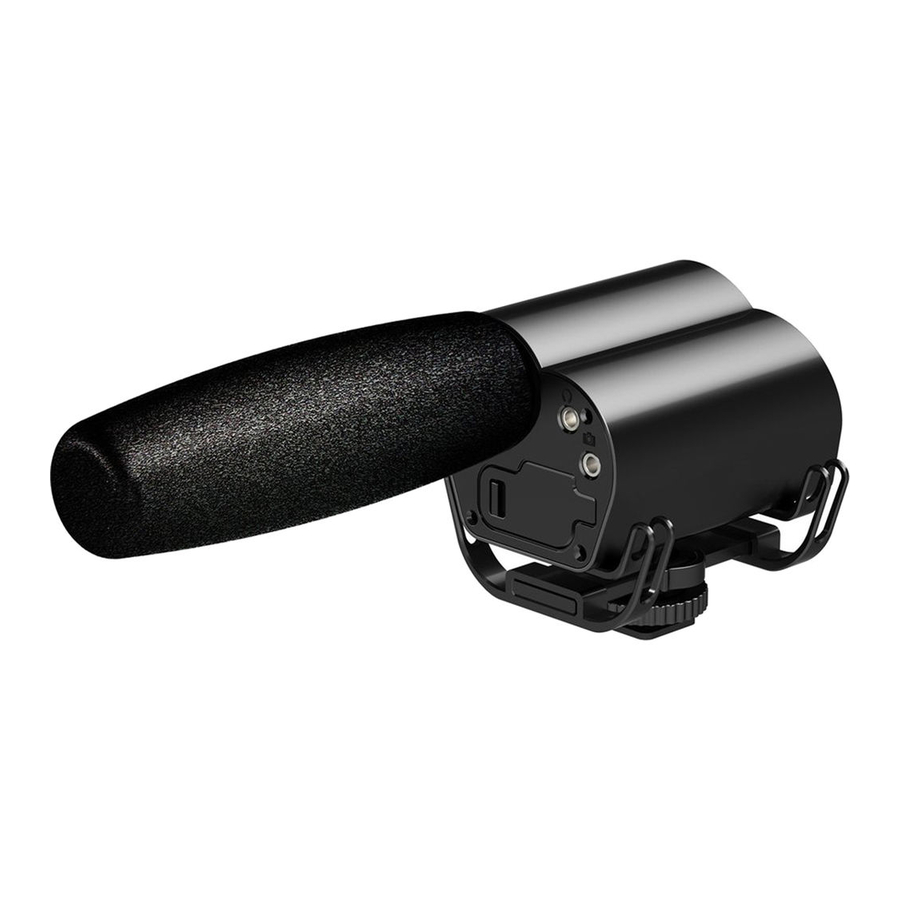
Saramonic Vmic - Broadcast Condenser Microphone Quick Start Guide
- User manual ,
- Manual (17 pages) ,
- Manual (2 pages)
Advertisement

Product Introduction
The Saramonic Vmic is a broadcast quality condenser microphone that provides professional audio with DSLR cameras and camcorders.
General Introductions
The Vmic is a broadcast quality condenser microphone that provides professional audio with DSLR cameras and camcorders. The Vmic allows you to adjust level control (-10dB, 0dB, +20dB), high-pass filter(150 Hz), and high-frequency boost(+6dB) to increase intelligibility of dialogue. The detachable 3.5mm cable connects the Vmic to the audio input of the camera, while the stereo headphone output allows you to monitor the incoming audio. The shock mount system provides isolation from vibration and mechanical noise.
Highlights
- Super-cardioid polar pattern
- Integrated shock mount system
- High pass filter (150 Hz)
- High frequency boost (+6dB)
- Three position level control (-10dB, 0dB, +20dB)
- Headphone monitor output
- 1/8'' audio output jack to camera
- LED power on/low battery indicator
- Wind shield included
- Lightweight all-mental construction
- Powered by two AA batteries
Packing List
- One Vmic main unit
- One foam windshield
- One signal transmission line
- User manual
- Warranty card
Product Structure

- Three position level control (-10dB, 0dB, +20dB)
- LED indicator
- Power button
- High frequency boost (+6dB)
- High-pass filter (150Hz)
To attenuate signals with frequencies lower than 150 Hz. It can be used to remove rumble or other low frequency noise while recording. - Integrated shock mount

- Audio output jack
- Headphone output
- Battery compartment
Set Up Guide
- Install the battery
- Lock the battery compartment
- Unlock the battery compartment
![]()
Insert the AA batteries into place aligning + and - polarity as shown.
- Attach the Vmic to your camera's or camcorder's hot shoe. Connect the supplied audio transmission line from Vmic's audio output to the MIC input of the camera or camcorder.
- Turn on your camera and long press the power button to turn the Vmic on, the LED indicator will turn green. When the battery power is low, the LED indicator will turn red.
- Adjust the level control according to your needs.
The -10dB level is ideal for recording loud sound sources, such as live music, motorsport, or interviews where the subject is very close to the camera.
The +20dB level boost is designed for use with DSLR cameras, allowing the user to reduce the camera's preamp level (or mic-input level), effectively reducing the amount of noise generated by the camera's comparatively low quality audio circuitry. - Plug a headphone to the headphone output of the Vmic, then you can monitor the audio.
We suggest you could do a test recording and playback the audio to see if it is acceptable.
Specification
| Type | Condenser Microphone (Unidirectional) |
| Polar Pattern | Super-cardioid |
| Frequency Response | 35-20kHZ |
| Sensitivity | -40dB +/- 1dB / 0dB=1V/Pa, 1kHz |
| Signal to Noise Ratio | 75dB or more |
| Output Impedance | 200Ohm or less |
| Power | Two AA batteries |
| Plug | Mini-pin plug (3.5mm) |
| Filter | High-pass filter (150Hz) |
| Dimensions(L*H*D) | 255 x 66 x 80 mm |
| Net Weight | 196g (6.9 oz.) |
Polar Pattern

Frequency Response

| The Saramonic logo is trademark which is registered and owned by Saramonic International. COPYRIGHT 2011-2021 SARAMONIC INTERNATIONAL |

Documents / Resources
References
Download manual
Here you can download full pdf version of manual, it may contain additional safety instructions, warranty information, FCC rules, etc.
Download Saramonic Vmic - Broadcast Condenser Microphone Quick Start Guide
Advertisement













Need help?
Do you have a question about the Vmic and is the answer not in the manual?
Questions and answers